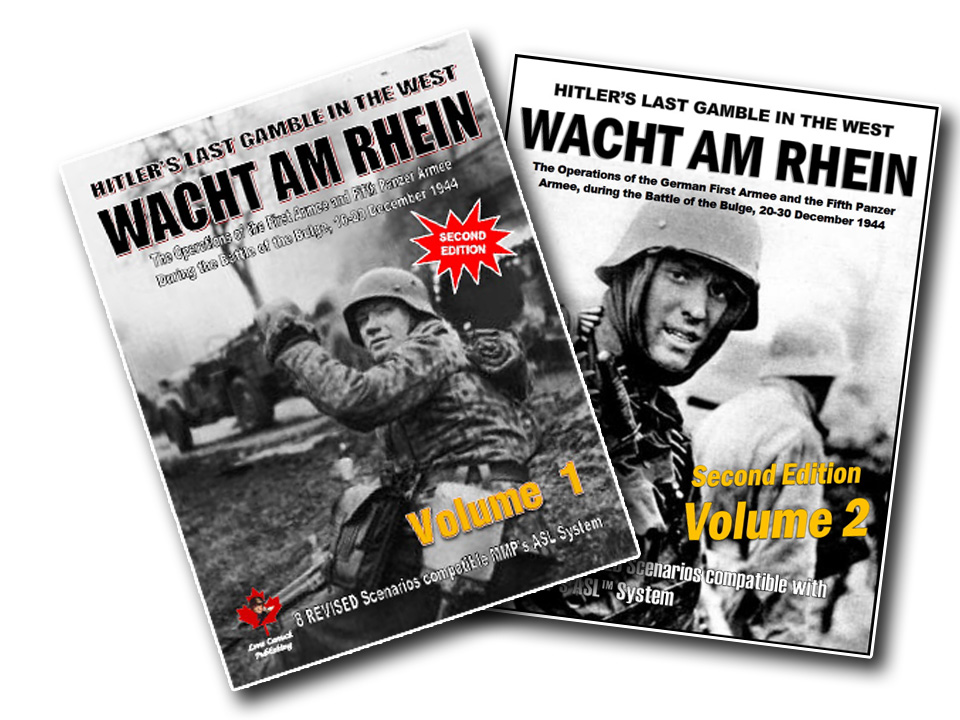Description

Combo: Wacht Am Rhein Vol. 1 and 2.
16 Scenarios that are so life-like your toes will get frostbite. All 16 scenarios at one discounted price.
Volume 1: On 16 December 1944, the Germans launch the last major offensive of the war, initial called Wacht am Rhein (Watch on the Rhein) and later changed to Unternehmen Herbstnebel(Operation Autumn Mist), it was an attempt to push the Allied front line west from northern France to northwestern Belgium. The Ardennes Offensive or more commonly known as the “Battle of the Bulge”, so-called because the Germans created a “bulge” around the area of the Ardennes forest in pushing through the American defensive line, was the largest fought on the Western front.
Map Boards Required: 2, 10, 16, 17, 24, 33, 40, 42, 43, 49, 53, 62, & 67
Wacht am Rhein 2nd Edition, Volume 1 contains
-
one counter sheet with 140 x 1/2″ counters
-
eight ASL scenarios
This pack is the 1st Volume of the 2nd Edition of the Wacht am Rhein Pack. All scenarios have undergone some modification, be it to their order of battle, boards, or victory conditions.
WaR 1 – MARNACH, LUXEMBOURG, 16 December 1944: The 2.Panzerdivision and its new commander, Oberst Meinrad von Lauchert, had no real responsibilities during the first phase of Unternehmen Herbstnebel. However, its first priority was to capture the bridge over the Clerf River at Clervaux, before advancing on Bastogne.
WaR 2 – BERDORF, LUXEMBOURG, 16 December 1944: In the early morning hours, the 212.Volksgrenadierdivision made a successful and relatively uneventful crossing of the Sauer River, managing to overrun the American outposts along the river line before they could get out any warning. Under orders to rapidly close with their objectives of the American command post in Consdorf and artillery positions in Scheidgen.
WaR 3 – HOSINGEN, LUXEMBOURG, 17 December 1944: The 26.Volksgrenadierdivision’s orders were to establish bridgeheads across the Clerf River by nightfall of the 16th; so any enemy resistance had to be either subdued quickly or bypassed. As it turned out, what impeded the 77.Volksgrenadierregiment’s advance was Company K, 3rd Battalion, 110th Infantry Regiment and Company B, 103rd Engineer Battalion in Hosingen, who commanded the crossroads on top of “Skyline Drive”.
WaR 4 – LONGSDORF-TANDEL ROAD, Luxembourg 17 December 1944: Screened by the mist, which aided all of assault companies of the 352.Volksgrenadierdivision; the leading two battalions by chance struck at the junction between the 109th Regiment’s battalions, whose 2d Battalion’s Company E was in Führen and the 3rd Battalion’s Company I deployed in front of Bettendorf.
WaR 5 – FRINGERHOF, LUXEMBOURG, 17 December 1944: Alerted by the German 7.Armee’s preliminary artillery barrage, Lieutenant-Colonel James Rudder, commanding officer of the 109th Infantry Regiment moved Company G up on the right of Company F, replacing it in Brandenburg by Company C from the regiment’s reserve 1st Battalion, which was stationed in Diekirch.
WaR 6 – HOSCHEID, LUXEMBOURG, 17 December 1944: Before dawn on 16 December the engineers of the 5.Fallschirmpioneriebataillon began ferrying the assault companies of 14.Fallschirmregiment across the Our River. Their instructions were to head as rapidly as possible west to the Clerf River, establish a bridging site near Kautenbach, and then press on west to Wiltz to establish a blocking line behind the Sûre River, south of Bastogne.
WaR 7 – DIEKIRCH LUXEMBOURG, 19 December 1944: By early evening 916.Volksgrenadierregiment had command of the heights in the Our/Sûre triangle and 914.Volksgrenadierregiment, taking up its place in the centre of the division’s line, could begin to make more headway. The US 109th Regiment, with Lieutenant-Colonel Rudder’s command post back in Ettelbruck, was now formed in an arc in front of Diekirch. However it was a sadly depleted regiment.
WaR 8 – BOIS DE HERBAIMONT, BELGIUM, 20 December 1944: While Panzer Lehr Division was still struggling toward the Clerf River on 18 December, 2.Panzerdivision was rolling west across the river through Clervaux. In the vanguard, was the reinforced Aufklärungsabteilung commanded by Hauptmann von Böhm. Taking the road which skirts to the north of Donnange and Lullange, the Kampfgruppe ran into the first of the Bastogne roadblocks at the Antoniushof farm road junction – a task force from CCR/9th Armored Division.
Volume 2: On 16 December 1944, the Germans launch the last major offensive of the war, initial called Wacht am Rhein (Watch on the Rhein) and later changed to Unternehmen Herbstnebel(Operation Autumn Mist), it was an attempt to push the Allied front line west from northern France to northwestern Belgium. The Ardennes Offensive or more commonly known as the “Battle of the Bulge”, so-called because the Germans created a “bulge” around the area of the Ardennes forest in pushing through the American defensive line, was the largest fought on the Western front.
Map Boards Required: 3, 4, 5, 10, 11, 12a, 16, 19, 23, 24, 33, 42, 43, 56, 85, & s
Wacht am Rhein 2nd Edition, Volume 2 contains
-
Special Rules for WaR scenarios; and
-
Eight ASL scenarios
This pack is the 2nd Volume of the 2nd Edition of the Wacht am Rhein Pack, picking up from where Volume 1 left off. All scenarios have undergone some modification, be it to their order of battle, boards, or victory conditions, similar to what was done with Volume 1.
WaR 9 – SAMRÉE,, BELGIUM, 20 December 1944: The 116.Panzerdivision was ordered to retrace its footsteps and head northwest through Houffalize towards La Roche and Samée instead. The 7th Armored Division’s main supply depot had been moved to just outside Samée and the only other defenders around Dochamps and Samée at this time were engineers of the 51st Engineer Combat Battalion. (Estimated playing time: 6 hrs 24 mins)
WaR 10 – WARDIN, BELGIUM, 20 December 1944: As Bastogne defenses were being rapidly reinforced, Company I, 3rd Battalion, 501st Parachute Infantry Regiment started entering Wardin from the northwest, unseen in the morning mist. Elements of Panzer Lehr’s Aufklärungsabteilung moved in from the northeast at the same time and the two groups inevitably collided. (Estimated playing time: 5 hrs 27 mins)
WaR 11 – GREVILS-BRÉSIL, LUXEMBOURG, 23 December 1944: Called out of OKW Reserve on 22 December, the Führer Grenadier Brigade would try to fill the vacuum between the 5.Fallschirmjägersivison and the 352.Volksgrenadierdivision. Kahler put one company of Fusiliers apiece into Eschdorf and Heiderscheid and sent two south with a platoon of Panthers to Grevils-Brésil, hoping to establish contact with the leading regiment of the 352.Volksgrenadierdivision. (Estimated playing time: 6 hrs 50 mins)
WaR 12 – LHEIDERSCHEID, LUXEMBOURG, 24 December 1944: Fresh from reserve, the understrength 79.Volksgrenadierdivision assembled behind the Führer Grenadier Brigade near Eschdorf. After a ten-minute artillery barrage, it attack Heiderscheid just before dawn. The village was defended by the Americans of the 2nd Battalion, 319th Infantry Regiment. (Estimated playing time: 7 hrs 0 mins)
WaR 13 – ROCHEFORT, BELGIUM, 24 December 1944: Kampfgruppe von Poschinger, took St. Hubert without any resistance on the night of 22 December before continued onwards to the important road centre of Rochefort. Early on 23 December, the Germans shelled the town before sending in reconnaissance patrol, which reported the town undefended. Rochefort was in fact well defended by the Americans of the 3rd Battalion, 335th Infantry Regiment. (Estimated playing time: 4 hrs 33 mins)
WaR 14 – VERDENNE, BELGIUM, 24 December 1944: The La Roche Bridge had to be repaired by the division’s engineers; so, after withdrawing from Hotton, it was not until 23 December that the westward advance of the 116.Panzerdivison resumed. The intention of the commander of the 116.Panzerdivison, Generalmajor von Waldenburg, was to cut the Hotton-Marche road, capture Marche, and advance toward Ciney, securing the right flank of 2.Panzerdivision. (Estimated playing time: 7 hrs 0 mins)
WaR 15 – FOY-NOTRE-DAME, BELGIUM, 25 December 1944: By midday, 23 December, Kampfgrüppe von Böhm had reached Buissonville and by nightfall was just outside Achêne, only 20 kilometres from the Meuse at Dinant. Even Feldmarschall von Rundstedt sent a message of congratulations, for nowhere else had the offensive achieved so much. By midnight saw von Böhm‘s men at the hamlet of Foy-Notre-Dame with only 6 kilometres to their goal. (Estimated playing time: 16 hrs 32 mins)
WaR 16 – VILLERS-LA-BONNE-EAU, BELGIUM, 30 December 1944: The attack on Villers-la-Bonne-Eau began at 04:45 hours on 30 December with the Fallschirmjägerregiment 14 leading companies, closely followed by the mounted SS-Panzergrenadiers and Panzerjäger IVs of Kampfgrüppe Hansen, 1.SS-Panzerdivision Leibstandarte SS Adolf Hitler. Companies K and L, US 137th Infantry Regiment were ensconed in the village awaiting the imminent attack. (Estimated playing time: 9 hrs 12 mins)






Reviews
There are no reviews yet.